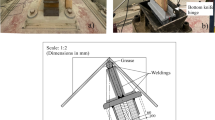Abstract
In ‘Blockhaus’ systems the structural capacity derives from surface interactions and friction mechanisms between multiple timber logs stacked horizontally one upon each other. Unlike masonry or concrete walls, timber log-walls are characterized by the absence of a full structural interaction between the basic components, hence resulting in ‘assembled’ rather than ‘fully monolithic’ structural systems characterized by high flexibility of timber and usually high slenderness ratios. The current Eurocode 5 for timber structures, however, does not provide formulations for the prediction of the critical load of log-haus walls under in-plane compressive loads. In this work, based on past experimental tests and detailed Finite-Element (FE) models, extended numerical investigations are performed on timber log-walls. A wide number of configurations (more than 900) characterized by different geometrical properties, timber log cross-sections, number and position of door and window openings, presence of in-plane rigid (RF) or fully flexible (FF) inter-storey floors, as well as initial curvatures and/or load eccentricities, are analyzed under monotonic in-plane compressive load. Careful consideration is also given to the influence of additional out-of-plane pressures (e.g., wind pressures) combined with the in-plane compressive load. In accordance with the buckling design approach proposed by the Eurocode 5 for timber columns, non-dimensional buckling curves are then proposed for timber log-walls under in-plane compression. These curves are based on an accurate calibration of the k c buckling coefficient and the related imperfection factors on the results of the numerical parametric study. The developed simple and conservative approach for the design of log-walls can be proposed for implementation in the new generation of the Eurocode 5.













Similar content being viewed by others
References
Baláž I (2005) Lateral torsional buckling of timber beams. Wood Research 50(1):52–58
Bedon C, Fragiacomo M (2015) Numerical and analytical assessment of the buckling behaviour of Blockhaus log-walls under in-plane compression. Eng Struct 82:134–150
Bedon C, Rinaldin G, Izzi M, Fragiacomo M, Amadio C (2015) Assessment of the structural stability of Blockhaus timber log-walls under in-plane compression via full-scale experiments. Constr Build Mater 78:474–490
Bouras F, Chaplain M, Nafa Z (2010) Experimental and modeling buckling of wood-based columns under repeated loading, Proceedings of the 14th International Conference on Experimental Mechanics, Poitiers, France, 4–9 July 2010, code 110074
Bouras F, Chaplain M, Nafa Z, Breysse D, Tran H (2012) Experimental behavior of wood columns under extreme loading: cyclic buckling. Proceedings of the World Conference on Timber Engineering WCTE 5:545–550
Eilering S, Beißner E (2011) On the stability of circular curved beams of glue-laminated timber [Zur Stabilität von BSH-Kreisbogenbindern]. Bauingenieur 86(2):76–83
EN 1993-1-1: 2005—Eurocode 3—Design of steel structures—Part 1-1: general rules and rules for buildings. European Committee for Standardization (CEN), Brussels, Belgium
EN 1995-1-1-2005—Eurocode 5—Design of timber structures—Part 1-1: General and rules for buildings. European Committee for Standardization (CEN), Brussels, Belgium
EN 1996-1-1:2005—Eurocode 6—Design of masonry structures—Part 1-1: General rules for reinforced and unreinforced masonry structures, European Committee for Standardization (CEN), Brussels, Belgium
EN 338 (2009). Structural timber-strength classes. European Committee for Standardization (CEN), Brussels, Belgium
EuroWood Construction (NZ) (2016) www.eurowood.co.nz. Accessed July 2015
Haller P, Hartig J, Wehsener K (2014) Application of moulded wooden tubes as structural elements, Proceedings of the World Conference on Timber Engineering WCTE2014, Quebec City, Canada, 10–14 August 2014; Code 110957
Heimeshoff B, Kneidl R (1992a) Zur Abtragung vertikaler Lasten in Blockwänden—Experimentelle Untersuchungen (Carrying of vertical loads by walls of log houses) (In German). Holz Roh- Werkst 50:173–180
Heimeshoff, B, Kneidl, R (1992b) Bemessungsverfahren zur Abtragung vertikaler Lasten in Blockwänden. (Methods of calculation for walls of log houses under vertical loads) (In German) Holz Roh-Werkst 50:441–448
Hofmann R, Kuhlmann U (2014) Simplified design of glued laminated timber girders for the torsional moment caused by stability effects, materials and joints in timber structures, pp. 823–830, ISBN 978-94-007-8710-8
Kessel MH (2012) Imperfections of pitched timber trusses [Imperfektionen von satteldachförmigen Fachwerkträgern aus Holz]. Bauingenieur 87(1):277–287
Leicester RH (2009) Buckling strength of timber structures. Aust J Struct Eng 9(3):249–256
LogHomeScotland (United Kingdom) (2016). www.loghomescotland.co.uk. Accessed July 2015
Malhotra SK (1989) Recent developments relating to design of solid and built-up timber compression members. Int J Hous Sci Appl 13(1):35–44
Namiki H, Nasu H (2014) Study on prevention for buckling of combined pillar with fiber materials or screws, proceedings of the world conference on timber engineering WCTE2014, Quebec City, Canada, 10–14 August 2014; Code 110957
PERR Blockhäuser (Germany) (2016). www.perr-blockhaus.de. Accessed July 2015
Polar Life Haus® (Finland) (2016). www.polarlifehaus.com. Accessed July 2015
Rodman U, Saje M, Planinc I, Zupan D (2013) The lateral buckling of timber arches. Int J Struct Stab Dyn 13(08):16. doi:10.1142/S0219455413500405
Rubner Haus AG Spa (Italy) (2016) www.rubnerhaus.com. Accessed July 2015
Rusticasa Construções Lda (Portugal) (2016). www.rusticasa.pt
Satterwhite Log Homes (TX, USA) (2016). www.satterwhite-log-homes.com. Accessed July 2015
Schnabl S, Turk G, Planinc I (2011) Buckling of timber columns exposed to fire. Fire Saf J 46(7):431–439
Simulia (2012) ABAQUS v.6.12 Computer Software, Dassault Systems, Providence, RI, USA
Taheri F, Nagaraj M, Khosravi P (2009) Buckling response of glue-laminated columns reinforced with fiber-reinforced plastic sheets. Compos Struct 88(3):481–490
The Original Lincoln Logs© (NY, USA) (2016). www.lincolnlogs.com. Accessed July 2015
Theiler M, Frangi A, Steiger R (2013) Strain-based calculation model for centrically and eccentrically loaded timber columns. Eng Struct 53(11):1103–1116
Xiao Q, Doudak G, Mohareb M (2014) Lateral torsional buckling of wood beams: FEA-modelling and sensitivity analysis, proceedings of the world conference on timber engineering WCTE2014, Quebec City, Canada, 10–14 August 2014; Code 110957
Zahn JJ (1973) Lateral stability of wood beam-and-deck systems. ASCE J Struct Div 99(ST7):1391–1408
Acknowledgments
DPC-ReLUIS is gratefully acknowledged for partially funding the research activity within the framework of the “PR4-Timber structures” project.
Author information
Authors and Affiliations
Corresponding author
Electronic supplementary material
Below is the link to the electronic supplementary material.
Rights and permissions
About this article
Cite this article
Bedon, C., Fragiacomo, M. Derivation of buckling design curves via FE modelling for in-plane compressed timber log-walls in accordance with the Eurocode 5. Eur. J. Wood Prod. 75, 449–465 (2017). https://doi.org/10.1007/s00107-016-1083-5
Received:
Published:
Issue Date:
DOI: https://doi.org/10.1007/s00107-016-1083-5




